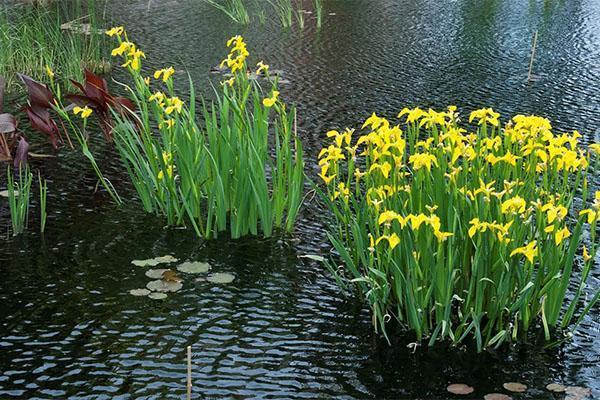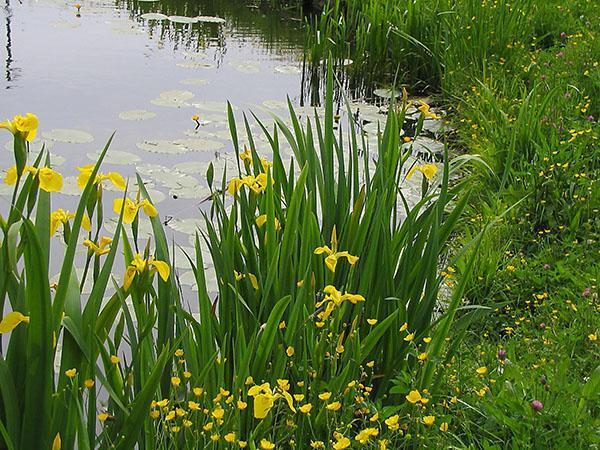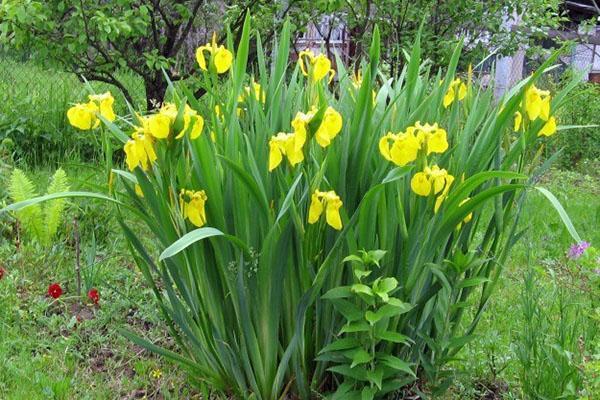Decoration of a country pond - marsh iris
 There is a decorative pond in the garden, and you don't know how to revive it? Iris marsh to perfectly cope with the task. The people also call it pseudoair (Iris pseudacorus, translated from Latin) or yellow.
There is a decorative pond in the garden, and you don't know how to revive it? Iris marsh to perfectly cope with the task. The people also call it pseudoair (Iris pseudacorus, translated from Latin) or yellow.
Botanical reference

It is worth noting that marsh iris (a photo of this handsome man is presented) has the properties of a hydrohor. In simple terms, seeds iris They spread through the water, because, once in the latter, they do not drown for a long time due to the presence of air-filled cavities between the seed itself and the peel and the non-wettability of the latter. It is assumed that waterfowl are also involved in the spread of the plant.
It is noteworthy that the marsh iris is represented by a single species and human activity does not interfere with its distribution at all. On the contrary, it only contributes to the "capture" of new lands.
Iris marsh: planting and care
The main advantage is problem-free care, which attracts gardeners even more.
Lighting
 The plant prefers bright light, and it is not at all afraid of the direct rays of the sun. However, it can grow in places with partial shade.
The plant prefers bright light, and it is not at all afraid of the direct rays of the sun. However, it can grow in places with partial shade.
The soil
 Marsh iris is also not picky about the soil, but the ideal is heavy soil, saturated with substances of organic origin and having an acidity below "7". At the same time, the plant will grow without problems in low-lying places, where a large amount of water accumulates.
Marsh iris is also not picky about the soil, but the ideal is heavy soil, saturated with substances of organic origin and having an acidity below "7". At the same time, the plant will grow without problems in low-lying places, where a large amount of water accumulates.
Watering
 Based on the foregoing, it is clear that when iris grows near water bodies, there is no need for irrigation. At the same time, if the planting was carried out in a regular substrate, iris should be regularly watered and the earthy coma should not dry out. Particular attention should be paid to the young.
Based on the foregoing, it is clear that when iris grows near water bodies, there is no need for irrigation. At the same time, if the planting was carried out in a regular substrate, iris should be regularly watered and the earthy coma should not dry out. Particular attention should be paid to the young.
Reproduction
 There are no problems in reproduction either. Among the existing methods, seed and vegetative are distinguished.
There are no problems in reproduction either. Among the existing methods, seed and vegetative are distinguished.
The first is the simplest. It is enough just to collect the seeds and sow in the autumn in moist soil. Seedlings will appear in the spring.
Along with the ease, there is also the main drawback of the method - the flowering of the plant will not occur earlier than in 3-4 years.
 For reproduction in the second way, it is enough to cut the "kids" from the rhizome. This can be done from the onset of spring to autumn.
For reproduction in the second way, it is enough to cut the "kids" from the rhizome. This can be done from the onset of spring to autumn.
But it is best to do this in the spring, when the plant starts growing.
In this case, two main rules must be observed:
- When dividing the rhizome, the iris should not bloom.
- The rhizome should also have buds or leaves. Moreover, the latter must be cut off before planting, leaving only 20-30 cm of the entire length.
Pests and diseases
As for pests, most often the plant is affected by gladiolus thrips, of which the leaves are a favorite part. True, in the 80s. there was a case of an "attack" by the iridescent sawfly caterpillars. But the problem was quickly dealt with thanks to insecticides.
Decorativeness and design
 Marsh iris is a dream for any gardener. In addition to ease of care, beauty, problem-free reproduction, the flower finds a worthy place in flower arrangements. It is used in:
Marsh iris is a dream for any gardener. In addition to ease of care, beauty, problem-free reproduction, the flower finds a worthy place in flower arrangements. It is used in:
- Compositions featuring shrubs and trees.
- Building green fences.
- In flower beds next to perennial flowers.
- Ecosystems are hand-built.
- Also, the plant looks incomparable on the lawn separately from other flowers.
 Marsh yellow iris is an ideal plant for arranging any water bodies. And given its versatility and survivability in arid conditions, excessive humidity, lack of a good drainage system, it is also irreplaceable.
Marsh yellow iris is an ideal plant for arranging any water bodies. And given its versatility and survivability in arid conditions, excessive humidity, lack of a good drainage system, it is also irreplaceable.